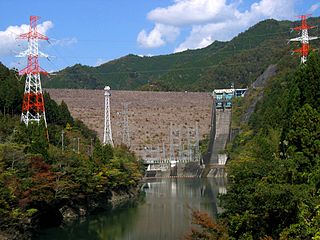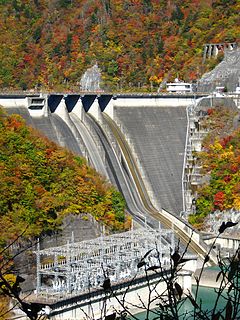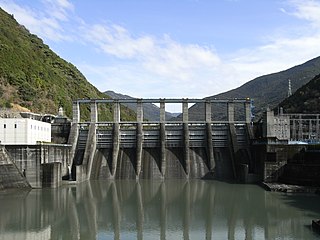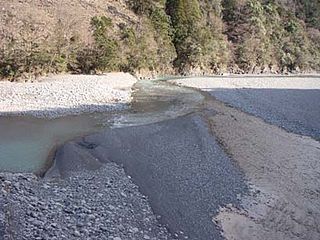
The Tenryū River is a river in central Honshū, Japan. With a length of 213 km (132 mi), it is Japan's ninth longest river.

The Tokuyama Dam is an embankment dam near Ibigawa, Ibi District, Gifu Prefecture in Japan. The dam was completed in 2008 and will support a 153 MW hydroelectric power station that is expected to be fully operational in 2015. Currently, Unit 1 at 23 MW was commissioned in May 2014. The dam was originally intended to withhold the upper reservoir of a 400 MW pumped-storage power station until a design change in 2004. The dam is also intended for flood control and water supply. It is the largest dam by structural volume in Japan and withholds the country's largest reservoir by volume as well.

The Sakuma Dam is a dam on the Tenryū River, located on the border of Toyone, Kitashitara District, Aichi Prefecture on the island of Honshū, Japan. It is one of the tallest dams in Japan and supports a 350 MW hydroelectric power station. Nearby a frequency converter station is installed, allowing interchange of power between Japan's 50 Hz and 60 Hz AC networks.

The Iwaya Dam is a dam in the city of Gero,Gifu Prefecture, Japan on the Maze River, part of the Kiso River system. The dam is a rockfill dam with a height of 127 meters and was constructed as a multipurpose dam for flood control, supply of municipal and industrial water, irrigation water and hydroelectric power generation. The reservoir created by the dam supplies the Chubu Electric Power Company's Mazegawa No.1 Power plant with a capacity of 288 MW hydroelectric power station.

Tanbara Dam is a rock-fill embankment dam on a Tone River tributary in Gunma Prefecture of Japan. It is located 14 kilometres (8.7 mi) north of Numata. It creates the upper reservoir for the 1,200 megawatts (1,600,000 hp) Tamahara Pumped Storage Power Station (玉原発電所). Construction began in 1973 and the dam was complete in 1981 while the power station was commissioned in 1986. It is 116 metres (381 ft) tall and withholds a reservoir with a storage capacity of 14,800,000 m3 (11,999 acre⋅ft). Of that capacity, 13,000,000 cubic metres (11,000 acre⋅ft) is active for power generation. The lower reservoir for the pumped-storage power station is created by the Fujiwara Dam, located 4 km (2 mi) to the northwest on another Tone River tributary. Power is generated during periods of high energy demand and pumping occurs during times when energy demand is low such as at night. The power station contains four 300 megawatts (400,000 hp) reversible Francis turbine pump-generators which serve to both pump water and generate electricity. The upper Tamahara Reservoir is at an elevation of 1,177 metres (3,862 ft) and the lower Fujiwara Reservoir is at 651 metres (2,136 ft) which affords the power station an effective hydraulic head of 518 metres (1,699 ft). When pumping, the pump-generators can move up to 210 cubic metres per second (7,400 cu ft/s) of water and when generating, they discharge up to 276 cubic metres per second (9,700 cu ft/s).

The Shiroyama Dam is a multi-purpose dam on the main stream Sagami River in Sagamihara, Kanagawa Prefecture on the island of Honshū, Japan.

The Ōigawa Dam is a dam on the Ōi River in Haibara District, Kawanehon, Shizuoka Prefecture on the island of Honshū, Japan. It has a hydroelectric power generating station owned by the Chubu Electric Power Company.

The Hatanagi-I is a dam on the Ōi River in Aoi-ku, Shizuoka, Shizuoka Prefecture on the island of Honshū, Japan. With a height of 125 metres (410 ft), it is the tallest hollow-core concrete gravity dam in the world. It has a hydroelectric power generating station owned by the Chubu Electric Power Company. It supports a 137 megawatts (184,000 hp) pumped-storage hydroelectric power station.

The Ikawa Dam is a dam on the Ōi River in Aoi-ku, Shizuoka, Shizuoka Prefecture on the island of Honshū, Japan. It was the first hollow core concrete gravity dam to be constructed in Japan, and has a hydroelectric power generating station owned by the Chubu Electric Power Company.

The Sasamagawa Dam is a dam on the Sasama River, a tributary of the Ōi River, located on the border of the city of Shimada and the town of Kawanehon, Shizuoka Prefecture on the island of Honshū, Japan.

The Senzu Dam is a dam on the Sumata River, a tributary of the Ōi River, located in Kawanehon Town, Haibara District, Shizuoka Prefecture on the island of Honshū, Japan.

The Nagashima Dam is a dam on the Ōi River, located in Kawanehon Town, Haibara District, Shizuoka Prefecture on the island of Honshū, Japan.

The Akiba Dam is a dam on the Tenryū River, located in Tenryū-ku, Hamamatsu, Shizuoka Prefecture on the island of Honshū, Japan.

The Kannagawa Hydropower Plant (神流川発電所) is an under construction pumped-storage hydroelectric power plant near Minamiaiki in Nagano Prefecture and Ueno in Gunma Prefecture, Japan. The power plant utilizes the Minamiaiki River along with an upper and lower reservoir created by two dams, the upper Minamiaiki Dam and the lower Ueno Dam. The power station in between the two dams will contain six 470 megawatts (630,000 hp) pump-generators for a total installed capacity of 2,820 megawatts (3,780,000 hp). Unit 1 commenced commercial operation in 2005 and Unit 2 in 2012. When completed, the plant will have the second-largest pumped-storage power capacity in the world.

Ohashi Dam is a dam built on the Yoshino River in Agawa District, Kōchi Prefecture of Japan. This concrete dam 73.5m high. It is a hydroelectric dam of the Shikoku Electric Power Company. It supplies water to the company's hydroelectric plant, Ohashi Power Station, which can produce up to 5,500kW. It is the lower reservoir for a pumped-storage hydroelectric plant. The upper reservoir being Inamura Dam. Water flowing between these two can produce up to 615MW. It is a public works which The Japan Society of Civil Engineers has recommended as a site of Public Works Heritage.

The Shin-Takasegawa Pumped Storage Station (新高瀬川発電所) uses the Takase River to operate a pumped storage hydroelectric scheme about 12 kilometres (7.5 mi) west of Ōmachi in Nagano Prefecture, Japan. Part of the system is within Chūbu-Sangaku National Park.

The Matanoagawa Dam (俣野川ダム) is a concrete gravity dam on a tributary of the Hino River located 2.3 km (1 mi) south of Kōfu in Tottori Prefecture, Japan. Construction on the dam began in 1978 and it was complete in 1984. The primary purpose of the dam is hydroelectric generation and it creates the lower reservoir for the Matanoagawa Pumped Storage Power Station (俣野川発電所). It is 69.3 metres (227 ft) tall and creates a reservoir with a 7,940,000-cubic-metre (6,440 acre⋅ft) storage capacity. The power station is located on the southern bank of the reservoir and contains four 300 megawatts (400,000 hp) Francis pump-turbine-generators. The upper reservoir for the pumped-storage scheme is created by the Doyo Dam located 6 kilometres (3.7 mi) to the southeast in Okayama Prefecture. To generate power, water from the Doyo Dam is sent to the power station, used to generate electricity and then discharged into the Matanoagawa Reservoir. This occurs when energy demand is high and when it is low, water is pumped back up to the Doyo Dam as stored energy. The same pump-generators that pump the water to Doyo reverse and generate electricity when it is sent back down. The first generator was operational in 1992 and the last in 1996.
The Shintoyone Pumped Storage Power Station is a large pumped-storage hydroelectric power plant in Toyone, Kitashitara, Aichi Prefecture, Japan. With an installed capacity of 1,125 megawatts (1,509,000 hp), the plant is one of the largest pumped-storage power stations in Japan.






























